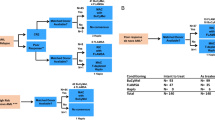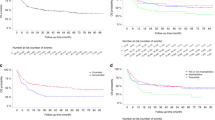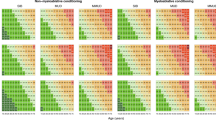Abstract
Allogeneic haematopoietic cell transplantation (HCT) is the most effective curative therapy in acute myeloid leukaemia (AML) and myelodysplastic syndromes (MDS). Incidence of AML and MDS increases with age, peaking in the seventh decade. Despite improved Ara-C and anthracyclin-based chemotherapy regimens, the prognosis of AML in patients beyond 60 years of age is dismal. The introduction of peripheral blood-derived stem cell grafts into allogeneic HCT and the known anti-leukaemic effect of donor lymphocyte infusions paved the way for reduced-intensity conditioning (RIC) allogeneic stem-cell transplantation, which makes transplant in advanced age possible and significantly reduces transplant-related organ toxicity and mortality. The success of RIC HCT relies on the alloreactivity of the donor immune system and the graft-versus-leukaemia effect. We try to answer the following questions in this paper: who should receive RIC HCT? when and how should the transplant be performed? is there an upper age limit and what is the future of RIC HCT?
This is a preview of subscription content, access via your institution
Access options
Subscribe to this journal
Receive 12 print issues and online access
$259.00 per year
only $21.58 per issue
Buy this article
- Purchase on Springer Link
- Instant access to full article PDF
Prices may be subject to local taxes which are calculated during checkout
Similar content being viewed by others
References
Thomas ED, Buckner CD, Clift RA, Fefer A, Johnson FL, Neiman PE et al. Marrow transplantation for acute nonlymphoblastic leukemia in first remission. N Engl J Med 1979; 301: 597–599.
Buckner CD, Clift RA, Thomas ED, Sanders JE, Stewart PS, Storb R et al. Allogeneic marrow transplantation for acute non-lymphoblastic leukemia in relapse using fractionated total body irradiation. Leuk Res 1982; 6: 389–394.
Clift RA, Buckner CD, Appelbaum FR, Sullivan KM, Storb R, Thomas ED . Long-term follow-Up of a randomized trial of two irradiation regimens for patients receiving allogeneic marrow transplants during first remission of acute myeloid leukemia. Blood 1998; 92: 1455–1456.
Appelbaum FR, Gundacker H, Head DR, Slovak ML, Willman CL, Godwin JE et al. Age and acute myeloid leukemia. Blood 2006; 107: 3481–3485.
Farag SS, Archer KJ, Mrozek K, Ruppert AS, Carroll AJ, Vardiman JW et al. Pretreatment cytogenetics add to other prognostic factors predicting complete remission and long-term outcome in patients 60 years of age or older with acute myeloid leukemia: results from Cancer and Leukemia Group B 8461. Blood 2006; 108: 63–73.
Frohling S, Schlenk RF, Kayser S, Morhardt M, Benner A, Dohner K et al. Cytogenetics and age are major determinants of outcome in intensively treated acute myeloid leukemia patients older than 60 years: results from AMLSG trial AML HD98-B. Blood 2006; 108: 3280–3288.
Storb R, Yu C, Barnett T, Wagner JL, Deeg HJ, Nash RA et al. Stable mixed hematopoietic chimerism in dog leukocyte antigen-identical littermate dogs given lymph node irradiation before and pharmacologic immunosuppression after marrow transplantation. Blood 1999; 94: 1131–1136.
Baron F, Maris MB, Sandmaier BM, Storer BE, Sorror M, Diaconescu R et al. Graft-versus-tumor effects after allogeneic hematopoietic cell transplantation with nonmyeloablative conditioning. J Clin Oncol 2005; 23: 1993–2003.
Hegenbart U, Niederwieser D, Sandmaier BM, Maris MB, Shizuru JA, Greinix H et al. Treatment for acute myelogenous leukemia by low-dose, total-body, irradiation-based conditioning and hematopoietic cell transplantation from related and unrelated donors. J Clin Oncol 2006; 24: 444–453.
Slavin S, Nagler A, Naparstek E, Kapelushnik Y, Aker M, Cividalli G et al. Nonmyeloablative stem cell transplantation and cell therapy as an alternative to conventional bone marrow transplantation with lethal cytoreduction for the treatment of malignant and nonmalignant hematologic diseases. Blood 1998; 91: 756–763.
Giralt S, Estey E, Albitar M, van Besien K, Rondon G, Anderlini P et al. Engraftment of allogeneic hematopoietic progenitor cells with purine analog-containing chemotherapy: harnessing graft-versus-leukemia without myeloablative therapy. Blood 1997; 89: 4531–4536.
Kottaridis PD, Milligan DW, Chopra R, Chakraverty RK, Chakrabarti S, Robinson S et al. In vivo CAMPATH-1 H prevents graft-versus-host disease following nonmyeloablative stem cell transplantation. Blood 2000; 96: 2419–2425.
Wäsch R, Reisser S, Hahn J, Bertz H, Engelhardt M, Kunzmann R et al. Rapid achievement of complete donor chimerism and low regimen-related toxicity after reduced conditioning with fludarabine, carmustine, melphalan and allogeneic transplantation. Bone Marrow Transplant 2000; 26: 243–250.
van Besien K, Artz A, Smith S, Cao D, Rich S, Godley L et al. Fludarabine, melphalan, and alemtuzumab conditioning in adults with standard-risk advanced acute myeloid leukemia and myelodysplastic syndrome. J Clin Oncol 2005; 23: 5728–5738.
Kroger N, Shimoni A, Zabelina T, Schieder H, Panse J, Ayuk F et al. Reduced-toxicity conditioning with treosulfan, fludarabine and ATG as preparative regimen for allogeneic stem cell transplantation (alloSCT) in elderly patients with secondary acute myeloid leukemia (sAML) or myelodysplastic syndrome (MDS). Bone Marrow Transplant 2006; 37: 339–344.
Shimoni A, Kroger N, Zabelina T, Ayuk F, Hardan I, Yeshurun M et al. Hematopoietic stem-cell transplantation from unrelated donors in elderly patients (age >55 years) with hematologic malignancies: older age is no longer a contraindication when using reduced intensity conditioning. Leukemia 2005; 19: 7–12.
Schmitz N, Eapen M, Horowitz MM, Zhang MJ, Klein JP, Rizzo JD et al. Long-term outcome of patients given transplants of mobilized blood or bone marrow: A report from the International Bone Marrow Transplant Registry and the European Group for Blood and Marrow Transplantation. Blood 2006; 108: 4288–4290.
Blume KG, Forman SJ, Nademanee AP, O'Donnell MR, Snyder DS, Fahey JL et al. Bone marrow transplantation for hematologic malignancies in patients aged 30 years or older. J Clin Oncol 1986; 4: 1489–1492.
Spyridonidis A, Bertz H, Ihorst G, Grullich C, Finke J . Hematopoietic cell transplantation from unrelated donors as an effective therapy for older patients (⩾60 years) with active myeloid malignancies. Blood 2005; 105: 4147–4148.
Ditschkowski M, Elmaagacli AH, Trenschel R, Steckel NK, Koldehoff M, Beelen DW . Myeloablative allogeneic hematopoietic stem cell transplantation in elderly patients. Clin Transplant 2006; 20: 127–131.
Deeg HJ, Storer B, Slattery JT, Anasetti C, Doney KC, Hansen JA et al. Conditioning with targeted busulfan and cyclophosphamide for hemopoietic stem cell transplantation from related and unrelated donors in patients with myelodysplastic syndrome. Blood 2002; 100: 1201–1207.
de Lima M, Anagnostopoulos A, Munsell M, Shahjahan M, Ueno N, Ippoliti C et al. Nonablative versus reduced-intensity conditioning regimens in the treatment of acute myeloid leukemia and high-risk myelodysplastic syndrome: dose is relevant for long-term disease control after allogeneic hematopoietic stem cell transplantation. Blood 2004; 104: 865–872.
Spyridonidis A, Kuttler T, Wasch R, Samek E, Waterhouse M, Behringer D et al. Reduced intensity conditioning compared to standard conditioning preserves the in vitro growth capacity of bone marrow stroma, which remains of host origin. Stem Cells Dev 2005; 14: 213–222.
Eapen M, Giralt SA, Horowitz MM, Klein JP, Wagner JE, Zhang MJ et al. Second transplant for acute and chronic leukemia relapsing after first HLA-identical sibling transplant. Bone Marrow Transplant 2004; 34: 721–727.
Deschler B, de Witte T, Mertelsmann R, Lubbert M . Treatment decision-making for older patients with high-risk myelodysplastic syndrome or acute myeloid leukemia: problems and approaches. Haematologica 2006; 91: 1513–1522.
Sorror ML, Maris MB, Storer B, Sandmaier BM, Diaconescu R, Flowers C et al. Comparing morbidity and mortality of HLA-matched unrelated donor hematopoietic cell transplantation after nonmyeloablative and myeloablative conditioning: influence of pretransplantation comorbidities. Blood 2004; 104: 961–968.
Tallman MS, Rowlings PA, Milone G, Zhang MJ, Perez WS, Weisdorf D et al. Effect of postremission chemotherapy before human leukocyte antigen-identical sibling transplantation for acute myelogenous leukemia in first complete remission. Blood 2000; 96: 1254–1258.
Platzbecker U, Thiede C, Fussel M, Geissler G, Illmer T, Mohr B et al. Reduced intensity conditioning allows for up-front allogeneic hematopoietic stem cell transplantation after cytoreductive induction therapy in newly-diagnosed high-risk acute myeloid leukemia. Leukemia 2006; 20: 707–714.
Estey E, de Lima M, Tibes R, Pierce S, Kantarjian H, Champlin R et al. Prospective feasibility analysis of reduced intensity conditioning regimens (RIC) for hematopoetic stem cell transplantation (HSCT) in elderly patients with acute myeloid leukemia (AML) and high-risk myelodysplastic syndrome (MDS). Blood 2007; 109: 1395–1400.
Schmid C, Schleuning M, Schwerdtfeger R, Hertenstein B, Mischak-Weissinger E, Bunjes D et al. Long-term survival in refractory acute myeloid leukemia after sequential treatment with chemotherapy and reduced-intensity conditioning for allogeneic stem cell transplantation. Blood 2006; 108: 1092–1099.
Hows JM, Passweg JR, Tichelli A, Locasciulli A, Szydlo R, Bacigalupo A et al. Comparison of long-term outcomes after allogeneic hematopoietic stem cell transplantation from matched sibling and unrelated donors. Bone Marrow Transplant 2006; 38: 799–805.
Appelbaum FR, Clift RA, Buckner CD, Stewart P, Storb R, Sullivan KM et al. Allogeneic marrow transplantation for acute nonlymphoblastic leukemia after first relapse. Blood 1983; 61: 949–953.
Martino R, Iacobelli S, Brand R, Jansen T, van Biezen A, Finke J et al. Retrospective comparison of reduced-intensity conditioning and conventional high-dose conditioning for allogeneic hematopoietic stem cell transplantation using HLA-identical sibling donors in myelodysplastic syndromes. Blood 2006; 108: 836–846.
Aoudjhane M, Labopin M, Gorin NC, Shimoni A, Ruutu T, Kolb HJ et al. Comparative outcome of reduced intensity and myeloablative conditioning regimen in HLA identical sibling allogeneic haematopoietic stem cell transplantation for patients older than 50 years of age with acute myeloblastic leukaemia: a retrospective survey from the Acute Leukemia Working Party (ALWP) of the European group for Blood and Marrow Transplantation (EBMT). Leukemia 2005; 19: 2304–2312.
Alyea EP, Kim HT, Ho V, Cutler C, Gribben J, DeAngelo DJ et al. Comparative outcome of nonmyeloablative and myeloablative allogeneic hematopoietic cell transplantation for patients older than 50 years of age. Blood 2005; 105: 1810–1814.
Wong R, Giralt SA, Martin T, Couriel DR, Anagnostopoulos A, Hosing C et al. Reduced-intensity conditioning for unrelated donor hematopoietic stem cell transplantation as treatment for myeloid malignancies in patients older than 55 years. Blood 2003; 102: 3052–3059.
Blaise DP, Michel BJ, Faucher C, Mohty M, Bay JO, Bardoux VJ et al. Reduced intensity conditioning prior to allogeneic stem cell transplantation for patients with acute myeloblastic leukemia as a first-line treatment. Cancer 2005; 104: 1931–1938.
Shimoni A, Hardan I, Shem-Tov N, Yeshurun M, Yerushalmi R, Avigdor A et al. Allogeneic hematopoietic stem-cell transplantation in AML and MDS using myeloablative versus reduced-intensity conditioning: the role of dose intensity. Leukemia 2006; 20: 322–328.
Schmitz N, Beksac M, Bacigalupo A, Ruutu T, Nagler A, Gluckman E et al. Filgrastim-mobilized peripheral blood progenitor cells versus bone marrow transplantation for treating leukemia: 3-year results from the EBMT randomized trial. Haematologica 2005; 90: 643–648.
Mohty M, Kuentz M, Michallet M, Bourhis JH, Milpied N, Sutton L et al. Chronic graft-versus-host disease after allogeneic blood stem cell transplantation: long-term results of a randomized study. Blood 2002; 100: 3128–3134.
Hartwig UF, Winkelmann N, Wehler T, Kreiter S, Schneider PM, Meyer RG et al. Reduced-intensity conditioning followed by allografting of CD34-selected stem cells and < or =10(6)/kg T cells may have an adverse effect on transplant-related mortality. Ann Hematol 2005; 84: 331–338.
Flowers ME, Traina F, Storer B, Maris M, Bethge WA, Carpenter P et al. Serious graft-versus-host disease after hematopoietic cell transplantation following nonmyeloablative conditioning. Bone Marrow Transplant 2005; 35: 277–282.
Marks DI, Lush R, Cavenagh J, Milligan DW, Schey S, Parker A et al. The toxicity and efficacy of donor lymphocyte infusions given after reduced-intensity conditioning allogeneic stem cell transplantation. Blood 2002; 100: 3108–3114.
Gorin NC, Labopin M, Boiron JM, Theorin N, Littlewood T, Slavin S et al. Results of genoidentical hemopoietic stem cell transplantation with reduced intensity conditioning for acute myelocytic leukemia: higher doses of stem cells infused benefit patients receiving transplants in second remission or beyond--the Acute Leukemia Working Party of the European Cooperative Group for Blood and Marrow Transplantation. J Clin Oncol 2006; 24: 3959–3966.
Baron F, Maris MB, Storer BE, Sandmaier BM, Panse JP, Chauncey TR et al. High doses of transplanted CD34+ cells are associated with rapid T-cell engraftment and lessened risk of graft rejection, but not more graft-versus-host disease after nonmyeloablative conditioning and unrelated hematopoietic cell transplantation. Leukemia 2005; 19: 822–828.
Author information
Authors and Affiliations
Corresponding author
Additional information
Based, in part, on a presentation at the EBMT meeting in Hamburg, March 2006.
Rights and permissions
About this article
Cite this article
Finke, J., Nagler, A. Viewpoint: What is the role of allogeneic haematopoietic cell transplantation in the era of reduced-intensity conditioning – is there still an upper age limit? A focus on myeloid neoplasia. Leukemia 21, 1357–1362 (2007). https://doi.org/10.1038/sj.leu.2404741
Received:
Revised:
Accepted:
Published:
Issue Date:
DOI: https://doi.org/10.1038/sj.leu.2404741
Keywords
This article is cited by
-
Age is no barrier for adults undergoing HCT for AML in CR1: contemporary CIBMTR analysis
Bone Marrow Transplantation (2022)
-
Reduced intensity conditioning of allogeneic hematopoietic stem cell transplantation for myelodysplastic syndrome and acute myeloid leukemia in patients older than 50 years of age: a systematic review and meta-analysis
Journal of Cancer Research and Clinical Oncology (2017)
-
Pretransplant NPM1 MRD levels predict outcome after allogeneic hematopoietic stem cell transplantation in patients with acute myeloid leukemia
Blood Cancer Journal (2016)
-
Non-replicating rhabdovirus-derived particles (NRRPs) eradicate acute leukemia by direct cytolysis and induction of antitumor immunity
Blood Cancer Journal (2013)
-
Promising Role of Reduced-Toxicity Hematopoietic Stem Cell Transplantation (PART-I)
Stem Cell Reviews and Reports (2012)



